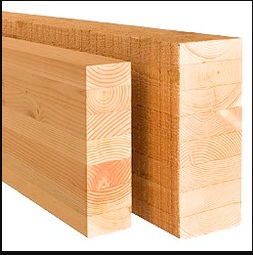Glulam is the short form of glued laminated timber. Glulam is formed by laying down several wooden planks or boards and bonding them with a strong, moisture-resistant adhesive. Structural wood products with lightweight and bearing capacity comparable to steel.
Properly made glued laminated timber is fire and earthquake-resistant.

This type of wood is suitable for use in beams, columns, ceilings, stairs, panels, and cladding. One of the great advantages of this type of structural lumber is that it can be easily arched or curved into beams or columns.
Another interesting feature is the variety of shades since different types of wood can be used. The most commonly used tree species include eucalyptus and pine in brown-pink or beige-pink varieties. Steel connectors can be used to connect different elements.
Table of Contents
Manufacturing Process of Glulam
The process of manufacturing glued laminated timber involves the manufacture of large structural elements from a number of small sawn parts. Laminate production has been standardized by EN14080 timber structures.
It consists of a laminate of wood laid out in layers and glued together in such a way that the fibers of the laminate run parallel to the longitudinal axis of the element. Horizontal plates are used more often than vertical plates because they are not suitable for curved elements.
Before gluing, the laminate is planned. The bonding process must be completed within 48 hours of planning.
Siberian larch, Douglas fir, spruce, and oak are particularly suitable species for the plywood used in the production of plywood veneers. The thickness of the laminate is determined by the depth of the element being made. For curved elements, the thickness of the laminate is determined by the radius over which the laminate must bend, and the type and quality of wood.
The production of adhesive laminated wood is carried out at optimum humidity to minimize shrinkage and expansion and to ensure dimensional stability of the final material.
Advantages of Glued Laminated Timber
- The production process of adhesive beams requires less energy. Therefore, it is a material with lower intrinsic energy compared to reinforced concrete or steel.
- Laminate can be produced in a variety of shapes without sacrificing structural requirements.
- They provide high strength and stiffness, allowing use for longer spans, heavier loads, and complex shapes.
- Glulam has a good strength-to-weight ratio compared to steel and concrete, which speeds up assembly.
- Glulam offers more design flexibility compared to traditional wood construction.
- Glulam structures are preferred over steel or concrete due to their natural appearance.
- Laminate is a large piece of wood that burns at a known rate. Therefore, it has good fire resistance.
Uses of Glulam in Construction
- Adhesive beam-wide roof construction for sports facilities.
- Create bridges and structures on embankments with glued beams treated under pressure.
- Construction of complex facilities such as churches, libraries, and school buildings
- For the construction of hurricane-resistant log cabins
